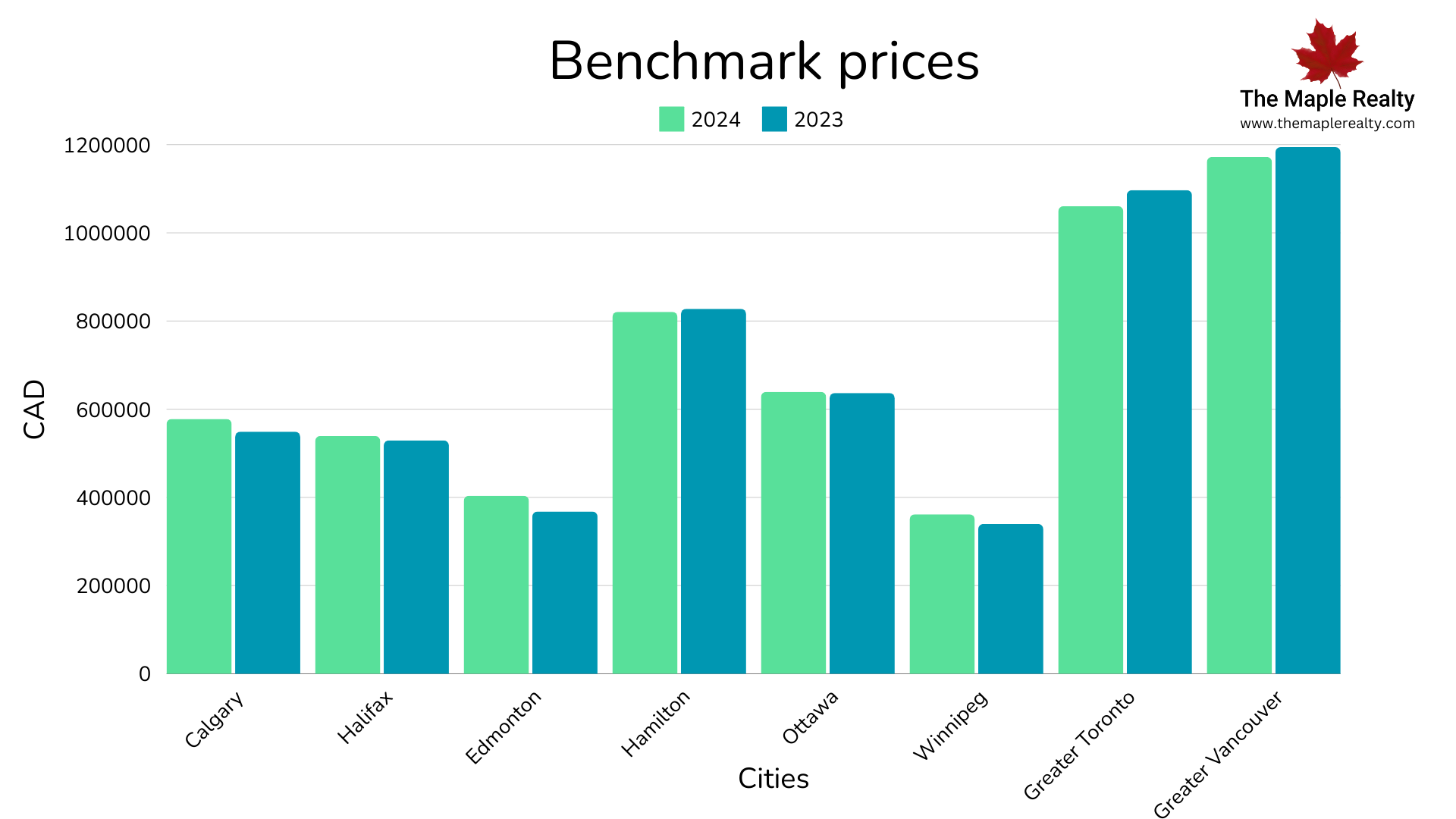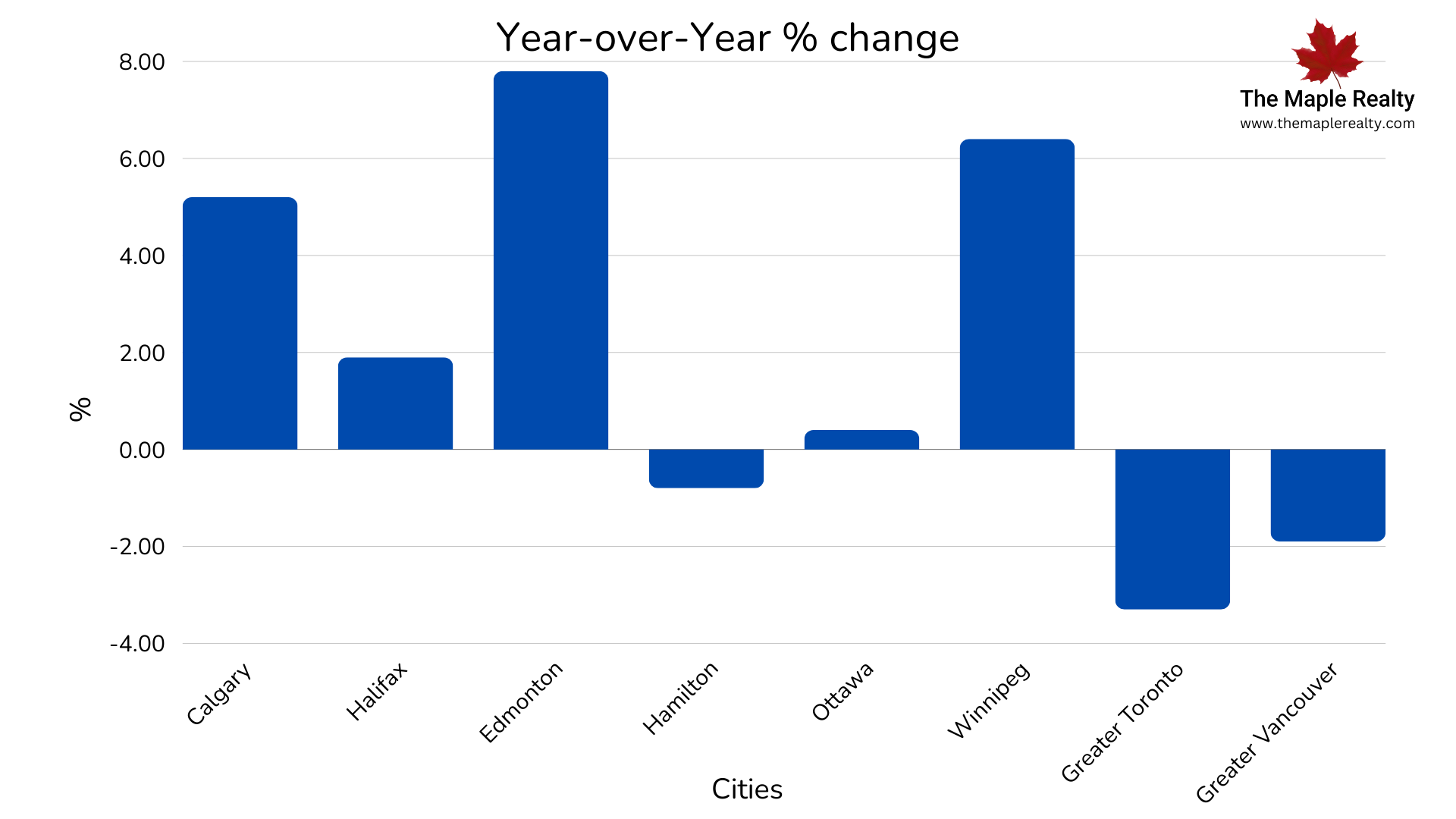Canadian real estate market in 2024 has seen some exciting shifts. Previously unknown cities are showing great growth and present a bit of competition to traditional housing powerhouses. Due to comparatively higher affordability and economic diversification, these locations are observing a notable growth in property values. With higher costs in urban centres like Greater Toronto Area (GTA), a migration trend is also apparent towards cities with more affordable housing and greater single-family housing options. From exciting growth in Alberta’s cities like Calgary and Edmonton to the steady appeal of Atlantic Canada’s Halifax, let’s see few of the cities which are seeing the shift in their real estate market. Whether you’re a potential buyer, investor, or simply curious about these booming markets, these cities highlight where the action is in Canadian real estate today.
Calgary, Alberta
Calgary, located in Alberta, is a vibrant city known for its stunning Rocky Mountain backdrop and booming energy sector. It combines urban amenities with outdoor adventure, making it a dynamic place to live and work. Looking at the housing trends for Calgary, we see that the both the average and the benchmark prices for all housing types have seen an increase. The benchmark prices have seen a 5.20% increase year-over-year to CAD 577,700 as of October 2024 whereas the average home prices have seen a significant increase as high as upto CAD 802,000 for detached homes, with the overall average prices at around CAD 620,000.
Compared with cities like Toronto and Vancouver, where average prices are into the seven figures, Calgary continues to offer affordable housing options, making it an attractive hotspot for real estate.
Halifax, Nova Scotia
Nova Scotia’s capital, Halifax, is a picturesque coastal city with a rich maritime history and a thriving cultural scene. Its waterfront, friendly vibe, and growing job market make it a top destination in Atlantic Canada. It’s natural beauty blended with economic stability has resulted in a steady real estate growth for the city. In October 2024, the benchmark prices for Halifax Dartmouth have been around CAD 539,200 which is a 1.9% increase from 2023. The average price has also seen an 8.9% increase to land at CAD 578,675.
Edmonton, Alberta
Let’s talk about Alberta’s capital city, Edmonton. The city is famous for its expansive river valley park system and lively arts and festival scene. With a mix of history and modern development, it is a hub of culture and innovation. In the last few years, Edmonton has emerged as a growing and affordable option for several first-time home buyers. The benchmark home prices in Edmonton, Alberta are at CAD 403,500 with a 7.80% year-over-year increase from 2023. Average home prices have been at CAD 440,089 with an 11% increase YoY. First-time home buyers and families have found their home in Edmonton, which may partly be attributed to affordable options at balanced prices, along with a growing job market.
Hamilton, Ontario
Hamilton, offers a blend of industrial heritage and scenic natural spaces. With its stunning location around Lake Ontario, the city is known for its growing arts community and urban revival. As of October 2024, the city and Hamilton-Burlington area has seen benchmark prices of around CAD 820,800. This is in fact a 0.8% decrease year-over-year from 2023. The overall average prices in the city are around CAD 821,512 which have seen a 4.1% YoY increase.
Hamilton’s proximity to Toronto and growing local economy have turned it into a magnet for buyers seeking affordability. The city’s vibrant culture and expanding infrastructure support its booming housing market.
Ottawa, Ontario
Canada’s capital city, Ottawa, is celebrated for its iconic landmarks like Parliament Hill and its multicultural charm. It’s a hub for government, tech, and education, offering a unique mix of history and modernity. Often overshadowed by Toronto, the city has been emerging as a popular option for home buyers. October 2024 showed a benchmark price of CAD 639,500, which is 0.40% increase YoY. The overall average home prices landed at CAD 668,690 with a 1.2% YoY. Although there is still a fluctuation in the market as evidenced by the 2.5% decrease month-over-month. However, the stable economy, fuelled by government and tech jobs, continues to support the real estate market. Steady price-growth and family-friendly environment continues to attract buyers and investors alike.
Winnipeg, Manitoba
Capital city of Manitoba, Winnipeg is a city of cultural diversity and thriving arts, with attractions like The Forks and the Canadian Museum for Human Rights. Known for its affordability and friendly community, it’s a welcoming prairie city. Benchmark prices in Winnipeg in October 2024 were CAD 361,400 with a 6.40% YoY increase. Average home prices have also seen a 2.9% increase. With the rising population and a balanced economy, Winnipeg is one of the more affordable housing markets in Canada at the moment. This makes it a popular choice for first-time buyers and investors.
Why the shift in the real estate market?
Historically, the population migration has been towards cities like Toronto (estimated population in 2024 – 2,928,879), Montreal (estimated population in 2024 – 1,796,826), Calgary (estimated population in 2024 – 1,506,479) etc, due to availability of amenities, jobs, and housing options. However, over the years, with increasing population influx, the availability of desired housing options have become less available, and prices have increased significantly. Comparing the mentioned cities here with centres like Greater Toronto and Greater Vancouver areas for the month of October, we can observe a significantly higher prices for GTA and Greater Vancouver.

Of course, over time, the prices are decreasing. This is reflected in YoY % changes of the GTA and Greater Vancouver areas.

Despite the decrease, the prices are still comparatively higher in these areas. This price difference has encouraged property explorers to branch out and find different attractive and affordable housing cities. Although, we are only comparing the month of October for the years 2023 and 2024, a parallel change is visible in the yearly price trends
If we look at the population migration of the people, then we see that since 2016, Toronto, Vancouver, Montreal and Quebec City have observed a population increase of 2.3%, 6.9%, 5.1%, and 4.5% respectively. However, the cities mentioned here, have also observed a significant population increase since 2016.The population of Calgary has increased by 6.4%, Halifax by 5.12%, Edmonton by 7.3%, Hamilton by 6.0%, Ottawa by 8.9%, and Winnipeg by 9.27%. Growing opportunities, amenities, stability in the real estate market, and affordability are channelling people towards previously unexplored cities.
The real estate market in Canada continues to be an exciting landscape with new markets and locations to explore.
Sources:
www.crea.ca/housing-market-stats/canadian-housing-market-stats/national-price-map/
https://worldpopulationreview.com/
Sources:
www.crea.ca/housing-market-stats/canadian-housing-market-stats/national-price-map/





